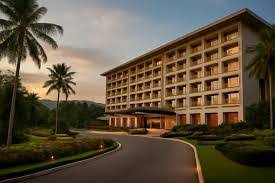Rapid Growth in Northeast India’s Branded Hotel Sector
Northeast India is undergoing a quiet yet significant transformation in its hospitality sector, with the number of branded hotel rooms expected to nearly double by 2030. Over 3,000 new rooms are set to be added across key states such as Assam, Arunachal Pradesh, Sikkim, Tripura, and Nagaland. This surge is predominantly led by Assam, particularly the city of Guwahati, signaling new opportunities for tourism development and investment in the region.
Statewise Expansion and Investment Focus
Assam is spearheading this expansion with an anticipated addition of approximately 2,000 branded hotel rooms from 2025 to 2030. The growth centers around Guwahati and emerging tourist hubs. Arunachal Pradesh is next in line with plans for 660 new rooms, highlighting rising confidence in destinations like Tawang and Itanagar. Sikkim follows with over 250 rooms in planning, while Tripura has 80 rooms lined up for 2026 and another 100 by 2030. Although Nagaland is part of the forecast growth, other states such as Mizoram and Meghalaya have yet to see significant branded hotel developments. This pattern underscores a concentration of investor activity primarily in Assam, with other states presenting untapped possibilities.
Key Statistics of Branded Hotel Supply Growth
| State | Existing Branded Rooms (2023) | Projected New Rooms by 2030 | Key Cities |
|---|---|---|---|
| Assam | ~2,300 | ~2,000 | Guwahati, other tourism hubs |
| Arunachal Pradesh | Minimal | 660 | Tawang, Itanagar |
| Sikkim | High proportion | 250+ | Gangtok |
| Tripura | Small existing supply | 180 (by 2030) | Agartala and others |
| Nagaland | Limited | Growth uncertain | Dimapur, Kohima |
Infrastructure Development and Tourism Potential
The region’s improving infrastructure plays a pivotal role in enticing more tourism and investment. Air traffic in Northeast India has rebounded impressively post-pandemic, with passenger volume reaching an all-time high of 11.2 million last year. Railway projects have accelerated, and rapid highway development is being prioritized by government bodies, enhancing connectivity across states.
However, regulatory complexities continue to hinder private investments, particularly in states beyond Assam. Experts recommend creating a harmonized investment framework along with a single-window clearance system to smoothen tourism project approvals. This approach is vital to ensure balanced development across all Northeastern states, preventing the bottleneck of supply in high-potential areas.
Historical Context of Hospitality and Tourism in Northeast India
Historically, Northeast India was often viewed as a remote and difficult-to-access region, which limited expansive tourism growth. Its natural beauty, rich culture, and diverse landscapes remained under the radar for many travelers and investors. Over the years, increased infrastructure projects and improved accessibility gradually shifted perceptions, paving the way for the present upsurge in tourism infrastructure.
Despite this positive momentum, Northeast India’s share of India’s branded hotel market remains modest, accounting for less than 3% of the national total. This contrasts with the concentration of branded hotel inventory in established urban centers like Guwahati and Gangtok.
Evolution of Tourism and Hospitality
- Early days: The Northeast’s geographical isolation limited tourism largely to domestic explorers and niche travelers interested in cultural and eco-tourism.
- Infrastructure Initiatives: Post-2000s, national policies emphasized enhancing transport—roads, air, and rail—to integrate the region better with the rest of India.
- Emerging Tourism Models: Introduction of sustainable and community-based tourism initiatives has begun to change how tourism operates, focusing on preserving local culture and environment.
- Rise of branded hotels: International and domestic hotel chains gradually entered key cities, offering higher standards of accommodation, prompting expectations for quality tourism experiences.
Prospects and Implications for Future Tourism
The hospitality boom forecast for Northeast India is promising but also serves as a reminder of the potential still untapped in several states. If connectivity and investment become more evenly distributed, this region could well become a preferred destination on South Asia’s tourism map. For now, Assam and adjacent hubs remain the hotspots for infrastructure-driven growth and tourism marketing efforts.
Tourism’s Role in Regional Development
Expanding branded accommodations is not just about increasing room counts—it’s about creating a holistic ecosystem that includes nearby marinas, restaurants, cultural activities, and transport services. Such development will naturally impact related sectors like boating, yachting, and water-based leisure, especially in regions with attractive lakes and rivers.
Potential Challenges Ahead
- Balancing Growth and Sustainability: Rapid expansion demands responsible tourism models to protect the environment and local communities.
- Investor Confidence Beyond Assam: States like Mizoram, Nagaland, and Meghalaya need targeted policies to attract investments.
- Infrastructure Gaps: While air and road links have improved, last-mile connectivity within remote areas still requires significant enhancement.
Conclusion: Emerging Tourism and Boating Synergies in Northeast India
The projected doubling of branded hotel rooms in Northeast India by 2030 reflects a robust hospitality sector awakening to newfound opportunities. This growth, led by Assam and buoyed by improved infrastructure, has the potential to transform the entire region into a vibrant tourism frontier. The alignment of sustainable tourism models and enhanced connectivity could open the door to more diverse recreational activities, including boating and water sports on the area’s scenic rivers and lakes.
For travelers seeking authentic experiences combined with comfortable stays, the escalating hospitality options present an inviting climate. Given the proximity to natural water bodies, this surge in demand for hotel rooms also hints at complementary growth in yacht charters, lake boating, and similar maritime activities that add value to the tourist experience.
For sailing and boating enthusiasts planning visits or yacht charters in this evolving landscape, Southeast Asia’s Northeastern states may soon present exciting new destinations. Enhanced marinas and waterfront developments could offer rich opportunities for boating activities amid breathtaking natural surroundings.
To explore the developing charter and rental markets within this promising region or others worldwide, consider reaching out to GetBoat.com, an international marketplace for renting sailing boats and yachts that caters to every taste and budget.

 Northeast India set for major branded hotel growth by 2030">
Northeast India set for major branded hotel growth by 2030">
